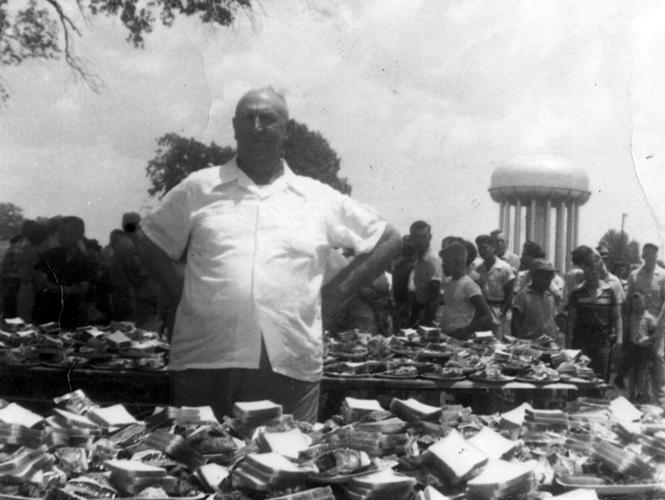When Bob Gibson decided to leave a secure job with the Louisville & Nashville Railroad to open a barbecue restaurant, he was taking a huge risk. But he had enough backyard cooking experience to give him the confidence to open his own place near his home on the Tennessee River in Decatur, Alabama.
Gibson’s gamble paid off. Big Bob Gibson’s şÚÁĎĘÓƵ is celebrating a century in business this year, and it remains in the same family.
Big Bob, nicknamed for his 6’4” height and his weight of about 300 pounds, took another chance in the year 1925. In a region where barbecue sauces were crafted in shades of red, Big Bob created a white one. None of his descendants can tell me exactly why he deviated so radically from Alabama barbecue tradition. But he did, and it worked.
When the business first began, Big Bob kept his white sauce in the kitchen, where he used it to “baptize” whole, barbecued chickens. Parts of those chickens came to diners’ tables dripping with Gibson’s new concoction.
Customers wanted more. Over the years, the kitchen-only restriction was lifted, and the restaurant staff brought what the owners still call “barbecue white sauce” out to diners’ tables in bottles, where it was squeezed liberally over pork shoulder and any other barbecued meat that Big Bob’s served.
Today, white barbecue sauce is a symbol of North Alabama. When I first began talking and writing about barbecue 25 years ago, I’d often get puzzled looks when I broached the topic of white sauce on barbecued meats. Now, Alabama white is just about as common and easy to find as South Carolina yellow.
Although they use different recipes, places like Kane Street Smokehouse in Gate City, Virginia, Southern Craft throughout Northeast Tennessee and Southwest Virginia, and Martin’s Bar-B-Que in Middle Tennessee all serve a version of white sauce.
I credit the late Alan Howell, longtime proprietor of şÚÁĎĘÓƵ’s Dixie Barbeque, for the popularity of Alabama white sauce in East Tennessee. Alan kept his white sauce in the back, under the radar. You had to ask for it. The reason for the secrecy, of course, is the fact that the sauce contains mayonnaise and can’t sit out all day like, for example, an Eastern North Carolina vinegar sauce.
Alan’s white sauce was at least as good as Big Bob’s. He told me he found the recipe in a telephone company cookbook. In addition to the tartness of the mayonnaise and lemon juice, it had a thickness that allowed it to adhere perfectly to barbecue meats.
Alan offered two side dishes with his barbecue plates, and I would often order two servings of the same thing, fried potatoes and onions, which were outstanding doused with his white sauce.
Recipes for Alabama white sauce are easy to find, including Big Bob’s original, which he shared widely. When I make it, I always use Duke’s Mayonnaise, another southern product that has risen from relative anonymity to nationwide popularity of late.
Duke’s adds a layer of tartness to the sauce and a bit of regional history, too, since Eugenia Duke’s company in Greenville, South Carolina, started making it in 1917, eight years before Big Bob gave up his railroad job.
Big Bob Gibson died in 1974, but his recipes and barbecue philosophy have continued on, through the restaurant ownership of his grandson, Don McLemore, and Big Bob’s great-granddaughter, Amy, and her husband, Chris Lilly. They serve other sauces besides white and consistently take top honors at the nation’s most prestigious barbecue competitions, including the American Royal in Kansas City and Memphis in May.
My favorite picture of Big Bob Gibson was taken in 1956. He is standing between tables overloaded with barbecue and light bread. The occasion is a Monsanto company picnic. Employees and their families are lined up behind him, ready to empty those tables. Big Bob looks into the distance, posed like a statue.
Says Chris Lilly, “That’s the way he catered — paper plates, barbecue and white bread.”
Fred Sauceman is the author of “The Proffitts of Ridgewood: An Appalachian Family’s Life in Barbecue.”
















